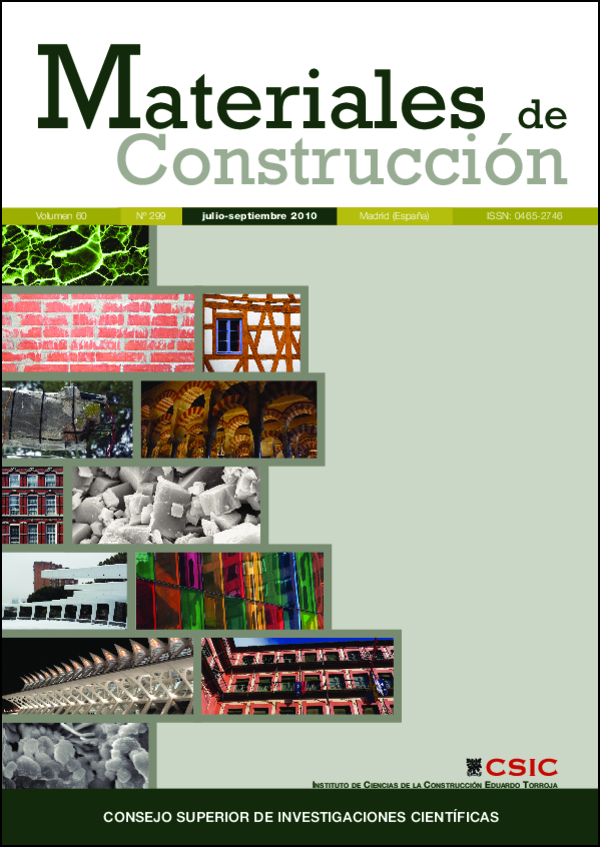Lichens as possible agents of sandstone deterioration in Jesuitic ruins of San Ignacio Miní (Misiones Province, Argentina)
DOI:
https://doi.org/10.3989/mc.2010.51209Keywords:
sandstone, lichens, SEM EDAX studies, characteristic tests, Misiones Province, ArgentinaAbstract
The ruins of San Ignacio Miní, in NE Argentina, Misiones Province, included by the UNESCO in the list of World Heritage in 1984, were built in the 18th century by the Guarani people under the supervision of the Jesuite Congregation. The ruins are located in a tropical weather zone, exposed to extreme conditions of heat and humidity affecting the rocks used in its construction. These rocks are identified as siliceous sandstones, mainly formed by rounded to subrounded clasts, with scarce angulose particles, containing 96% quartz. Weather characteristics encourage the growth of vascular plants as well as algae and mosses and other organisms that damage materials. Among these, there are 18 lichen species (belonging to 18 genera), 8 foliose, 3 fruticose and 7 crustose. The damaging action of these lichens has been observed through SEM observations and EDAX microanalysis of rock samples colonized by Caloplaca sp. and Buellia sp.
Downloads
References
(1) Comisión Nacional de Museos y Monumentos Históricos: Monumentos históricos de la República Argentina, pp. 55-56, Ediciones de Arte Gaglianone, Buenos Aires, (1998), véase también www.monumentos.org.ar/08mis/mis004.htm
(2) Equipo editorial de la revista Hábitat: “Misión jesuítico-guaraní de San Ignacio Miní. Restauración de la portada principal de la Iglesia. Finalización del proyecto”. Habitat, año XIV, nº 56 (2008), pp. 30-35.
(3) Wendler, E.; Prasarset, C.: “Lichen growth on Old Khmer styled sandstone monuments in Thailand: Damage factor or shelter?”. Preprints: 12th. Triennal meeting of the ICOM Commitee for Conservation (29 de agosto y 3 de septiembre de 1999), Lyon, pp. 759-754.
(4) Grondona, I.; Monte, E.; Rives, V.; Vicente, M. A.: “Lichenized association between Septonema tormes sp. Nov.; a coccoid cyanobacterium and a green alga with an unforeseen biopreservation effect of Villamayor sandstone at “Casa Lis” of Salamanca, Spain”. Mycological Research, vol. 108, nº 12 (1997), pp. 1489-1495. doi:10.1017/S0953756297004309
(5) Wessels, D. C. J.; Schoeman, P.: “Mechanism and rate of weathering of Clarens sandstone by an endolithic lichen”. South African Journal of Science, vol. 84, nº 4 (1988), pp. 274-277
(6) Ferraro, L. I.: “Contribución a la flora liquenológica de Corrientes (Argentina)”.FACENA, vol. 2 (1978), pp. 167-244.
(7) Ferraro, L. I.: “Contribución al estudio de las Parmeliáceas (líquenes) de Corrientes, Rep. Argentina”. Bonplandia, vol. 5, nº12 (1981), pp. 83-99.
(8) Adler, M.: “Clave de Parmeliaceae de la provincia de Buenos Aires”.Boletín Sociedad Argentina de Botánica, vol. 28, nº 1-2 (1992), pp. 11-17.
(9) Scutari, N. C.: “Estudios sobre Pyxinaceae foliosas (Lecanorales, Ascomycotina) de la Argentina IV: Clave de los géneros y las especies de la provincia de Buenos Aires”. Boletín Sociedad Argentina de Botánica, vol. 28, nº 1-2 (1992), pp. 169-173.
(10) Galloway, D. J.: “Studies on the lichen genus Sticta (Schreber) Ach.: I. Southern South American species”. Lichenologist, vol. 26, nº 3 (1994), pp. 223-282.
(11) Malme, G. O.: “Die Ramalinen der Ersten Regnellschen Expedition”.Ark. f. Bot.;vol. XXVI A, nº 13 (1934), pp. 1-10.
(12) Malme, G. O.: “Die Stictazeen der Ersten Regnellschen Expedition”.Ark. f. Bot.; vol. XXVI A, nº 14 (1934), pp. 1-18.
(13) Cortelezzi, C. R.; Colado, U.; Muñoz, L.: “Disyunción columnar en areniscas mesozoicas (Formación Misiones) República del Paraguay”. Notas del Museo de La Plata XXI, Geología,nº 76 (1988), pp. 170-176.
(14) Osorio, H. S.: “Contributions to the lichen flora of Argentina, II: Lichens from the Province of Misiones”. Comunic. Bot. Mus. Hist: Nat., Montevideo, vol. 4, nº 48 (1969), pp. 1-5.
(15) Osorio, H. S.: “Contributions to the lichen flora of Argentina, XIII: Lichens from Misiones Province.” Comunic. Bot. Mus. Hist: Nat., Montevideo, vol. 4, nº 63 (1981), pp. 1-18.
(16) Osorio, H. S.: “Contributions to the lichen flora of Uruguay, VII: A preliminary catalogue”. Comunic. Bot. Mus. Hist: Nat., Montevideo, vol. 4, nº 56 (1972), pp. 1-46.
(17) Osorio, H. S.: “Contributions to the lichen flora of Uruguay, VIII. Additions and corrections”. Comunic. Bot. Mus. Hist. Nat., Montevideo, vol. 4, nº 59 (1975), pp. 1-12.
(18) Osorio, H. S.; Homrich, M. H.: “Contributions to the lichen flora of Brazil IV: Lichens from Southern Rio Grande do Sul”. The Bryologist, nº 81 (1978), pp. 452- 454. doi:10.2307/3242255
Downloads
Published
How to Cite
Issue
Section
License
Copyright (c) 2010 Consejo Superior de Investigaciones Científicas (CSIC)

This work is licensed under a Creative Commons Attribution 4.0 International License.
© CSIC. Manuscripts published in both the print and online versions of this journal are the property of the Consejo Superior de Investigaciones Científicas, and quoting this source is a requirement for any partial or full reproduction.
All contents of this electronic edition, except where otherwise noted, are distributed under a Creative Commons Attribution 4.0 International (CC BY 4.0) licence. You may read the basic information and the legal text of the licence. The indication of the CC BY 4.0 licence must be expressly stated in this way when necessary.
Self-archiving in repositories, personal webpages or similar, of any version other than the final version of the work produced by the publisher, is not allowed.
















